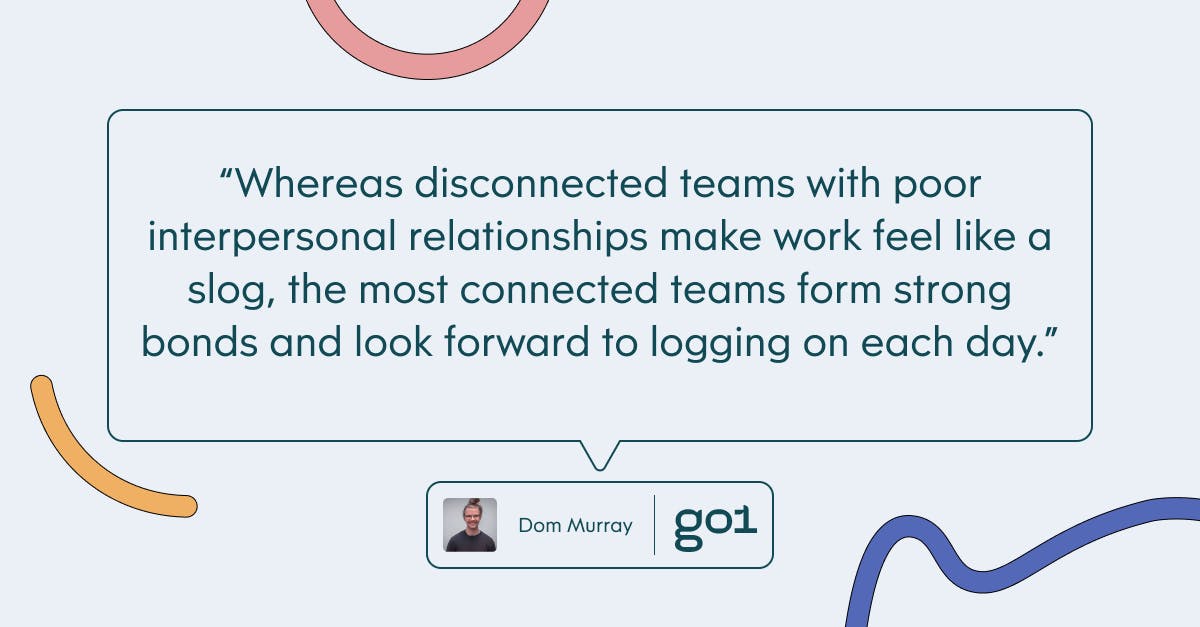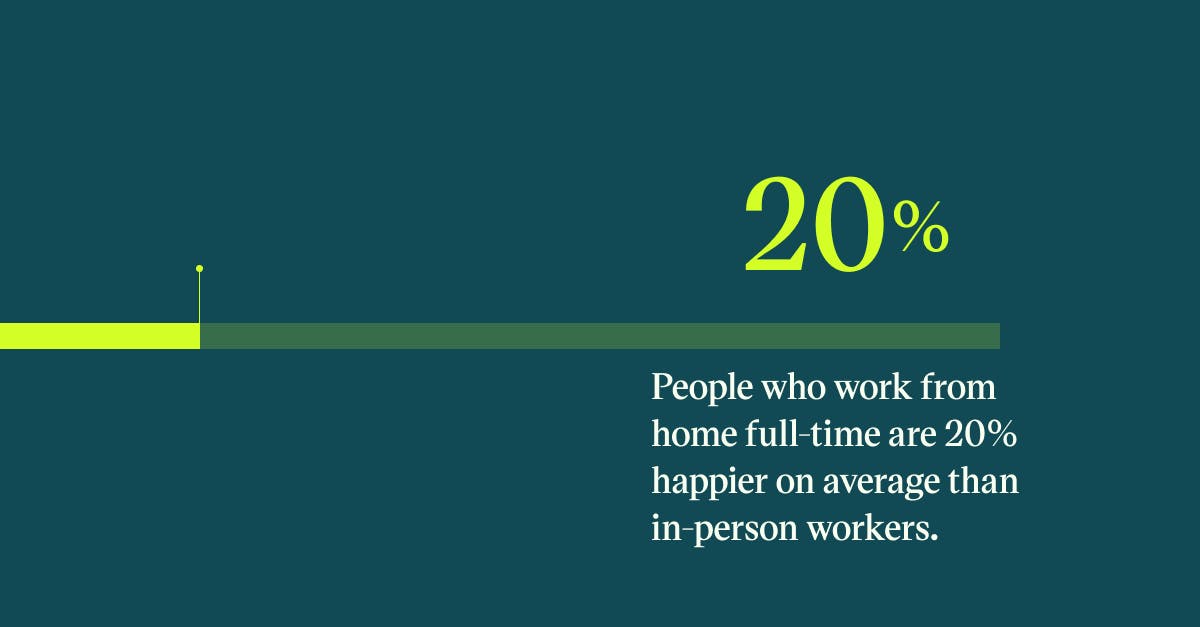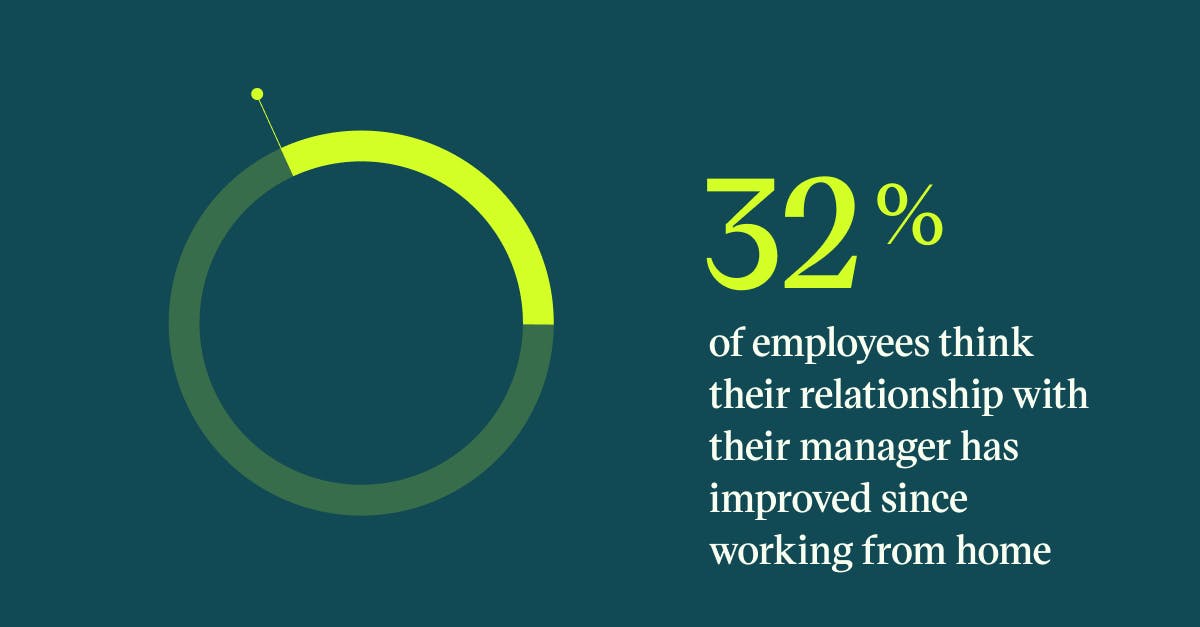
Building strong relationships in a remote work environment

Building strong relationships at work is vital for any team's happiness, togetherness, and productivity. Think back to a job you’ve had where that one teammate would constantly get on your nerves. Maybe they wouldn’t stop talking while you were trying to focus. Or perhaps you had to pick up their slack and take on extra work. Whatever it was, most of us likely have a story of a colleague or manager who rubbed you the wrong way and made you dread coming in to work the next day.
Ask yourself: did that improve your performance, or were you watching the clock, counting the seconds until you could get out of there? Whereas disconnected teams with poor interpersonal relationships make work feel like a slog, the most connected teams form strong bonds and look forward to logging on each day.

You don’t have to be best friends with your colleagues or think of them as a second family. However, a connected team built on open communication and mutual respect is essential. Fostering this connectivity is something that every organisation should strive for. In a remote work environment, where the threats of isolation, loneliness, and disconnection are higher, strengthening these relationships becomes doubly important.
With this in mind, we’ll explore the ins and outs of building strong relationships in a remote work environment. We’ll start by analysing the challenges of building strong relationships while working from home, before asking whether remote work has strengthened team relationships, and finally outlining three ways to build strong remote relationships.
The challenges of building strong relationships while working from home
While working from home has had appreciable, far-reaching benefits for most employees, one of the key challenges of remote work is building and maintaining strong relationships with your colleagues.
For instance, Buffer’s 2022 State of Remote Work Report found that 52% of people who started working remotely due to COVID-19 feel less connected to their co-workers. 30% say that it has had no impact, while, on a positive note, 18% feel more connected.
Additionally, Buffer’s report found that 24% of people struggle with loneliness while working remotely, while 17% say that ‘difficulties with collaboration and communication’ is a major challenge.
A similar study by LiveCareer found that 37% of remote workers think that collaboration and communication are significant challenges. Moreover, research by HowNow discovered that more than two-thirds of workers (67%) feel disconnected from their colleagues when working from home and 42% feel lonely.
Thus, while working remotely offers a plethora of benefits, including reduced stress levels, greater flexibility, and less time spent commuting, it is not without its challenges. Ensuring employees remain connected and engaged while simultaneously staving off loneliness should be a top priority for remote-first teams. To help your team achieve this, we’ll look at how remote work can strengthen relationships.
Has remote work strengthened team relationships?
While working remotely is not without its challenges, for most workers, the benefits have far outweighed the drawbacks. From increased happiness to more supported employees, we’ll take you through how remote work has strengthened team relationships.
Increase happiness
A study by Tracking Happiness found that people who work from home full-time are 20% happier on average than in-person workers. Likewise, a survey by CNBC and SurveyMonkey found that remote workers have a Workforce Happiness Index score of 72 out of 100.

Not only does working remotely increase happiness — it also significantly reduces stress. Research shows that 53% of employees would feel stressed if their employers required them to return to the office. To emphasise this point, Limeade found that “there was not a single employee that did not have any anxiety about returning to the office/worksite.”
It follows that happy, stress-free workers are significantly more likely to build strong interpersonal relationships!
Employees feel more supported
According to ADP Research Institute, two-thirds of remote workers feel their teams are highly supportive, compared to less than half of on-site employees (47%).
These findings make sense, as Buffer’s 2022 State of Remote Work Report found that 97% of employees want to continue working remotely in some capacity and would recommend remote work to others.
It’s no surprise that workers feel more supported when they feel employers are listening to their needs. So, fostering a supportive environment means that remote teams can build stronger relationships.
Improve productivity
Working remotely can also improve productivity. 75% of virtual teams say remote collaboration allows them to be more effective, while 85% of businesses think they are more productive thanks to flexible working policies.
A study by Stanford confirmed this, finding remote workers are 13% more productive than their in-office counterparts.
Again, it makes sense that happy, productive teams are more likely to be engaged and connected.
Build trust
According to the Future of Work Survey by PwC, executives (77%) and employees (72%) agree that there is a high level of trust between leaders and employees in remote work environments.
Likewise, Buffer finds that 93% of employees believe their organisation trusts them to work remotely.
Unsurprisingly, fostering a high degree of trust is critical to building connected teams.
Bringing your full self to work
Research by Microsoft finds that, since working remotely, 39% of people are more likely to be their full, authentic selves at work and 31% are less likely to feel embarrassed if their home life shows up at work.

To underscore this point, 17% of people have cried in front of a co-worker while working remotely, while 20% have met their colleagues' pets or family, thereby building deeper connections.
As Microsoft explains, “people who interacted with their co-workers more closely than before not only experienced stronger work relationships, but also reported higher productivity and better overall wellbeing.”
Better relationships at work
As a result, Miro finds that 32% of employees think their relationship with their manager has improved since working from home.

Further, 25% say their relationship with their colleagues has improved, while 21% say their relationship with peers on other teams has improved — concrete proof that you can still create connected teams while working remotely.
Better relationships at home
Finally, but perhaps most importantly, remote work doesn’t just help you build strong relationships with colleagues — it can also strengthen your relationship with loved ones.
Miro’s research finds that people report improved relationships with their spouse/partner (49%), young children (62%), and friends and extended family (30%).
Most likely, this is because workers have more free time to spend with loved ones. Buffer finds that 67% of employees say ‘flexibility in how I spend my time’ is the biggest benefit of remote work.
What’s more, 76% of employees now want flexibility in where they work, and 93% want flexibility in when they work. It’s easy to understand why employees want more flexibility, given how much working remotely has improved their relationships with loved ones.
3 ways to build connected remote teams
1. Emphasise clear communication
While it may seem obvious, emphasising clear, ongoing communication is a surefire way to build a connected remote team. As mentioned, 37% of remote workers think collaboration and communication are significant challenges.

So, what can remote teams do to overcome this challenge? To start with, ask yourself: what does clear communication look like for my team? Every team will be different, but a few tips include:
- Daily written check-ins, where each team member outlines their priorities for the day
- Daily round-ups, celebrating that day’s wins and accomplishments
- Regular stand-up meetings
- Consistent 1:1s
- Monthly lunch & learns
- Regular ‘social’ events, such as virtual games on a Friday afternoon
Again, every team will be different — clear communication for one team might feel like a total overload for another. So, the most important tip is to be aware of each team member's individual needs and foster an environment of open, honest communication where everyone feels comfortable reaching out and asking questions.
2. Focus on mental health
Mental health support can be a tricky balancing act when working remotely. On the one hand, Addeco finds that 42% of workers feel anxiety about returning to the office. In contrast, HowNow finds that 47% of remote workers experience anxiety.
In other words, there is no catch-all solution. Some employees find that remote work greatly aids their mental health, while others find it far more challenging.
One thing that a majority of workers (74%) agree on is that their company should increase the focus on mental health and staff wellbeing. Unfortunately, only 55% of employees feel their company cares about their mental health. These findings send a clear message to employers: step up your mental health and wellbeing support, particularly for remote teams.
To help correct this issue, McKinsey finds that employees would feel less stressed if they were offered things such as additional time off (62%), flexible work schedules (60%), and hybrid work arrangements (57%).
For further insights, see our articles on why mental health education in workplaces is important and developing your mental health self-care plan.
3. Beware digital burnout
Finally, it is vital to combat digital burnout when building a connected remote team.
Unfortunately, a recent survey shows that 24% more remote staff experience emotional burnout than their office-based colleagues.
Largely, this is due to digital burnout. OwlLabs finds that people have been meeting on video calls 50% more often since 2020, while 65% of people worked more hours remotely than they had while working in the office. Accordingly, digital burnout is a serious threat.
The simplest solution to combat digital burnout? Encourage your team to take regular breaks. It really can be that easy.
Microsoft finds that taking regular breaks decreases the risk of employee burnout while also improving focus and engagement and helping people manage stress. Obviously, less burnout leads to happier, more engaged employees and stronger, more connected teams.
We dig into Microsoft’s research in detail here, so if you want to learn more, check out our article on why our brains need breaks to maintain productivity.
For more insights, subscribe to the Go1 newsletter to stay on top of all the latest L&D trends. Or, you can book a demo today to find out how Go1 can help with your team’s learning needs.




